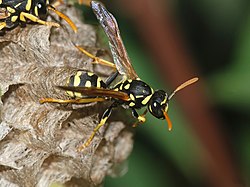This is an old revision of this page, as edited by Ohnoitsjamie (talk | contribs) at 14:04, 10 October 2012 (if you continue to edit war against consensus, you will be blocked). The present address (URL) is a permanent link to this revision, which may differ significantly from the current revision.
Revision as of 14:04, 10 October 2012 by Ohnoitsjamie (talk | contribs) (if you continue to edit war against consensus, you will be blocked)(diff) ← Previous revision | Latest revision (diff) | Newer revision → (diff)
The Schmidt Sting Pain Index is a pain scale rating the relative pain caused by different Hymenopteran stings. It is mainly the work of Justin O. Schmidt, an entomologist at the Carl Hayden Bee Research Center in Arizona. Schmidt has published a number of papers on the subject and claims to have been stung by the majority of stinging Hymenoptera.
His original paper in 1984 was an attempt to systematize and compare the hemolytic properties of insect venoms. The index contained in the paper started from 0 for stings that are completely ineffective against humans, progressed through 2, a familiar pain such as a common bee or wasp sting and finished at 4 for the most painful stings. In the conclusion, some descriptions of the most painful examples were given, e.g.: "Paraponera clavata stings induced immediate, excruciating pain and numbness to pencil-point pressure, as well as trembling in the form of a totally uncontrollable urge to shake the affected part."
Subsequently, Schmidt has refined his scale, culminating in a paper published in 1990 which classifies the stings of 78 species and 41 genera of Hymenoptera. Schmidt described some of the experiences in vivid detail.
An entry in The Straight Dope reported that the following "implausibly exact numbers" do not appear in any of Schmidt’s published scientific papers but were "wheedled out of him" by Outside magazine for an article it published in 1996.
| Index | Animal | Description given by Schmidt |
|---|---|---|
| 1.0 | Sweat bee | Light, ephemeral, almost fruity. A tiny spark has singed a single hair on your arm. |
| 1.2 | Fire ant | Sharp, sudden, mildly alarming. Like walking across a shag carpet and reaching for the light switch. |
| 1.8 | Bullhorn acacia ant | A rare, piercing, elevated sort of pain. Someone has fired a staple into your cheek. |
| 2.0 | Bald-faced hornet | Rich, hearty, slightly crunchy. Similar to getting your hand mashed in a revolving door. |
| 2.0 | Yellowjacket | Hot and smoky, almost irreverent. Imagine W. C. Fields extinguishing a cigar on your tongue. |
| 0 – 2.0 | Honey bee and European hornet | Like a matchhead that flips off and burns on your skin. |
| 3.0 | Red harvester ant | Bold and unrelenting. Somebody is using a drill to excavate your ingrown toenail. |
| 3.0 | Paper wasp | Caustic and burning. Distinctly bitter aftertaste. Like spilling a beaker of hydrochloric acid on a paper cut. |
| 4.0 | Tarantula hawk | Blinding, fierce, shockingly electric. A running hair drier has been dropped into your bubble bath. |
| 4.0!+ | Bullet ant | Pure, intense, brilliant pain. Like fire-walking over flaming charcoal with a 3-inch rusty nail grinding into your heel. |
See also
- Dol scale to measure pain
- Starr sting pain scale "A Pain Scale for Bee, Wasp and Ant Stings" by Christopher Starr
- Justin O. Schmidt The creator of the "Schmidt Sting Pain Index"
References
- Schmidt, J. O., Blum, M. S., and Overal, W. L. "Hemolytic activities of stinging insect venoms", Archives of Insect Biochemistry and Physiology, 1:155–160, 1984.
- Schmidt, Justin O. "Hymenoptera venoms: striving toward the ultimate defense against vertebrates" in D. L. Evans and J. O. Schmidt (Eds.), "Insect defenses: adaptive mechanisms and strategies of prey and predators" pp. 387–419, State University of New York Press, Albany, 1990.
- ^ Cecil Adams (May 11, 2012) Did the creator of the Schmidt Sting Pain Index volunteer to get stung by everything on earth?, The Straight Dope
- Berenbaum, May. "A Stinging Commentary", American Entomologist, v. 49 n. 2, pp. 68-69
- Conniff, Richard. "The King of Sting", in Outside, v. 21 n. 4 (April 1996), pp. 82–84, 147.
- Conniff, Richard. "Stung: How tiny little insects get us to do exactly as they wish", Discover, June 2003.
- Evans, David L. Insect Defenses: Adaptive Mechanisms and Strategies of Prey and Predators, Table 14.1, 1990. ISBN 0-88706-896-0